Characterization of the Stone Masonries and Evaluation of the Environmental Impact in Panamá Viejo: A Contribution for the Conservation of the Monumental Complex
Abstract
:1. Introduction
1.1. Historical Background and Site Location
1.2. Environmental Context
1.3. Geological and Geomorphological Setting
2. Materials and Methods
- Fortín de la Natividad: Constructed during the 17th century on the eastern side of the site. Currently located near the new Vía Cincuentenario and in front of a gas station;
- Convento de San Francisco: The construction began in 1603, situated in the eastern part of the archaeological site, adjacent to the new Vía Cincuentenario. It was one of the largest convents in Panamá Viejo, initially occupying around 5000 m2, which is now reduced to 3000 m2;
- Hospital de San Juan de Dios: Initially known as the “Saint Sebastian Hospital”, built two years after the foundation of the town. Renamed San Juan de Dios from 1620 onwards, it was named after the order that took over the hospital. The original area of the convent was 2500 m2, and is now reduced to 1500 m2. It consisted of a large stonewall structure incorporating a church, cloisters, rooms, patios, and the military hospital;
- Convento de las Monjas de la Concepción: Occupies an area of 1500 m2 on the western side of the town. The church was constructed a century later than the town’s foundation. In the 20th century, its ruins were damaged by the construction of a street perpendicular to Vía Cincuentenario, dividing the complex and the church in half;
- Convento de la Compañía de Jesús: Established in 1578 and located near the Plaza Mayor. Originally made of wood, but from the beginning of the 17th century, the convent was converted into stone masonry. The remaining structures include the church and the primary cloisters, dating back to after the 1621 earthquake;
- Casa Terrín: Overlooking the Plaza Mayor, this structure was constructed around 1600 by Francisco Terrín, one of the most powerful inhabitants of the town;
- Torre de la Catedral: Functioned as a belfry and watchtower, this stone masonry tower was built between 1619 and 1626, facing Plaza Mayor;
- Casas Reales: The most important architectural complex in the town, it held a prominent position in the public hierarchy. Built on bare rock foundations, its strategic location was the most salubrious, with a dominant position in the town and in relation to the sea. The complex was subjected to constant remodeling after it was seriously damaged during the 1621 earthquake. Following the town’s abandonment, the walls endured tidal erosion.
- -
- Stereomicroscope observations were performed by an Optika SZ6745TR, equipped with a webcam, MOTICAM 2005 5.0 Mp,. The Moticam Image Plus 2.0 software was utilized for preliminary analyses of the bulk samples;
- -
- Polarized light microscopy (PLM) was utilized for the observation of the thin sections, using an Olympus BX 51 microscope, equipped with scanner and the MICROMAX software “Primoplus_32” vers. 8.11.02;
- -
- X-ray powder diffraction (XRPD) was used for determining the mineralogical phases present, through a Philips PW 1730 diffractometer equipped with a copper anticathode and a nickel filter. The measurement conditions had a diffraction interval of 2θ, between 5° and 50°, a 2°/minute step at 40 kV voltage, and a 30 mA current intensity. In addition, further analyses were performed in order to verify the clay minerals present in several samples, utilizing a Bruker AXS D8, in Bragg–Brentano geometry, equipped with a X-ray tube and a SolX solid state detector, working in low-temperature through a Peltier cooling system. The samples for this technique underwent the powdering process, utilizing two mills: firstly, a jaw crusher and secondly a mortar grinder with agate jar and pestle. For materials with a high hardness, the process was finished by manual grinding with an agate mortar. Moreover, in order to examine the clay minerals in detail with the second diffractometer, analyses were repeated three times for each sample: the first one on a random mount sample (measurement conditions: time = 2 h 14′; slits = 1, 1, 0.2); then on iso-oriented powder (measurement conditions: time = 1 h 33′; slits = 0.6, 0.6, 0.2; 2θ = 2–30°); and finally, the latter one underwent ethylene glycol solvation (measurement conditions: time = 1 h 33′; slits = 0.6, 0.6, 0.2; 2θ = 2–30°).
- -
- Environmental scanning electron microscopy and microchemical investigations by energy dispersive X-ray spectrometry (ESEM-EDS) were carried out to determine the elemental composition of specific areas of interest, already observed in the PLM investigation. The instrument utilized was a ZEISS EVO LS 10 with LaB6 source;
- -
- X-ray fluorescence (XRF) on powder pellets (see the XRPD section for the powdering process), using a wavelength-dispersive automated ARL Advant’X spectrometer, was utilized. The accuracy and precision for major elements were estimated to be 2–5%; for trace elements (above 10 ppm), they were above 10%;
- -
- X-ray Fluorescence non-invasive micro-analysis (µXRF) performed using an ARTAX 200 μEDXRF spectrometer equipped by Mo X-ray tube and using a Peltier cooled Si (Li) detector, with a collimator with a diameter from 1 mm, a voltage of 50 kV, and a current of 700 μA (live time: 300 s), on bulk samples in order to evaluate the nature of the chromatic alterations;
- -
- Mercury intrusion porosimetry (MIP) was used for understanding the porosimetry features of the materials and the index of their state of conservation, using a porosimeter “PASCAL 240, THERMO SCIENTIFIC”;
- -
- Ion chromatography (IC) was used in order to evaluate the possible presence of soluble salts present in the masonry. IC analyses were performed using a DIONEX ICS 900. Anions analysis: Column S23 Pre-column G23; Cations analysis: Column CS12 Pre-column CG12.
3. Results and Discussion
3.1. Materials Characterization—Outcrops
3.2. Materials Characterization—Masonry
3.3. Evaluation of the State of Conservation
4. Conclusions
Author Contributions
Funding
Data Availability Statement
Acknowledgments
Conflicts of Interest
References
- UNESCO World Heritage Centre. Archaeological Site of Panamá Viejo and Historic District of Panamá. Available online: https://whc.unesco.org/en/list/790/ (accessed on 10 January 2023).
- Osorio Ugarte, K. Los Atributos Del Valor Universal Excepcional de Una Propiedad Considerada Patrimonio Mundial—El Caso Del Sitio Arqueológico de Panamá Viejo y Distrito Histórico de Panamá. Canto Rodado Rev. Espec. En Patrim. 2012, 7, 1–28. [Google Scholar]
- de Arango, J. El sitio de Panamá Viejo un ejemplo de gestión de patrimonio. Canto Rodado Rev. Espec. En Patrim. 2006, 1, 1–15. [Google Scholar]
- Ciantelli, C. Environmental Impact on UNESCO Heritage Sites in Panama. Ph.D. Thesis, University of Ferrara, Ferrara, Italy, 2017. [Google Scholar]
- Arroyo Duarte, S. Conservation, Reuse and Regeneration of Religious Cultural Heritage: The Case of the Archaeological Site of Panama Viejo and the Historic District of Panama. In Regenerating Cultural Religious Heritage; Niglio, O., Ed.; Springer Nature: Singapore, 2022; pp. 237–253. ISBN 978-981-19346-9-8. [Google Scholar]
- Cubero-Hernández, A.; Raony Silva, E.; Arroyo Duarte, S. Urban Layout of the First Ibero-American Cities on the Continent through Conventual Foundations: The Cases of Santo Domingo (1502) and Panama Viejo (1519). Land 2022, 11, 2144. [Google Scholar] [CrossRef]
- Cubero Hernández, A.; Arroyo Duarte, S. Colonial Architecture in Panama City. Analysis of the Heritage Value of Its Monastic Buildings. Designs 2020, 4, 57. [Google Scholar] [CrossRef]
- Arroyo Duarte, S. Panamá Viejo después de su destrucción. La cartografía, los grabados, las fotografías y las descripciones como ayuda para estudiar la historia del sitio arqueológico de Panamá Viejo. Canto Rodado Rev. Espec. En Patrim. 2015, 10, 11–38. [Google Scholar]
- Embajada de España en Panamá. Panamá Viejo: De la Aldea a la Urbe = Panamá Viejo: From Village to City; Araújo, W., Patronato Panamá Viejo, Programa de Patrimonio de la Cooperación Española, Eds.; Embajada de España en Panamá, Patronato Panamá Viejo: Ciudad de Panamá, Panama, 2007; ISBN 978-9962-8811-4-8. [Google Scholar]
- Correa de Sanjur, N. Historia de Panamá año I; M. Fernández y Cía.: Madrid, Spain, 1986; ISBN 978-84-401-1515-7. [Google Scholar]
- Tejeira-Davis, E. Panamá: Guía de Arquitectura y Paisaje; Junta de Andalucía: Sevilla, Spain, 2007; ISBN 978-84-8095-518-8. [Google Scholar]
- Mena García, C. Panamá En El Siglo XVIII: Trazado Urbano, Materiales y Técnica Constructiva. Rev. Indias 1997, 57, 369–398. [Google Scholar] [CrossRef]
- Ciantelli, C.; Sardella, A.; Arroyo Duarte, S.; Pecchioni, E.; Bonazza, A. The Monumental UNESCO Site of Panamá Viejo: Investigation of the Masonry Mortars. Heritage 2022, 5, 646–663. [Google Scholar] [CrossRef]
- Arroyo Duarte, S. Transformaciones En El Sitio Arqueológico de Panamá Viejo: El Ejemplo de Las Casas Reales. Ph.D. Thesis, Universitat Politècnica de València, Valencia, Spain, 2016. [Google Scholar]
- “Carta del fiscal Bartolomé Morquecho”, 26 de octubre de 1608, PANAMA, 15: R.9, N. 96, Archivo General de Indias, Sevilla, Spain. Available online: http://pares.mcu.es/ParesBusquedas20/catalogo/description/380615?nm (accessed on 10 June 2023).
- Roden, G.I. Sea Level Variations at Panama. J. Geophys. Res. 1963, 68, 5701–5710. [Google Scholar] [CrossRef]
- Alba Carranza, M.M. Geografía Descriptiva de La República de Panamá, 2nd ed.; El Panamá América: Panama City, Panama, 1946. [Google Scholar]
- Jay, D.A. Evolution of Tidal Amplitudes in the Eastern Pacific Ocean. Geophys. Res. Lett. 2009, 36, L04603. [Google Scholar] [CrossRef]
- Strong, N.; Maekawa, T.; Rovira, B. Rates and Patterns of Coastal Erosion for the Panama Viejo Historical and Archeological Site. In Proceedings of the Abstracts with Programs—Geological Society of America, Portland, OR, USA, 18–21 October 2009; Geological Society of America (GSA): Boulder, CO, USA, 2009; Volume 41, p. 156. [Google Scholar]
- Arroyo Duarte, S. Informe Sobre Las Casas Reales Del Sitio Arqueológico de Panamá Viejo; Patronato Panama Viejo: Panama City, Panama, 2008. [Google Scholar]
- Kottek, M.; Grieser, J.; Beck, C.; Rudolf, B.; Rubel, F. World Map of the Köppen-Geiger Climate Classification Updated. Meteorol. Z. 2006, 15, 259–263. [Google Scholar] [CrossRef]
- Ciantelli, C.; Palazzi, E.; von Hardenberg, J.; Vaccaro, C.; Tittarelli, F.; Bonazza, A. How Can Climate Change Affect the UNESCO Cultural Heritage Sites in Panama? Geosciences 2018, 8, 296. [Google Scholar] [CrossRef]
- Arnold, A.; Zehnder, K. Salt Weathering on Monuments. In Proceedings of the I Simposio Internazionale Bari 7–10 Giugno La Conservazione dei Monumenti Nel Bacino del Mediterraneo; Fulvio Zezza: Bari, Italy, 1989; pp. 31–58. [Google Scholar]
- Autoridad Nacional del Ambiente. Atlas Ambiental de La República De Panamá, 1st ed.; Autoridad Nacional del Ambiente: Panama City, Panama, 2010; p. 190. ISBN 978-9962-651-49-9. [Google Scholar]
- Camuffo, D. Physical Weathering of Stones. Sci. Total Environ. 1995, 167, 1–14. [Google Scholar] [CrossRef]
- Knutsen, K.L. La Yeguada Volcanic Complex, Western Panama: An Assessment of the Geologic Hazards Using New 40AR/39Ar Ages. Master’s Thesis, Michigan Technological University, Houghton, MI, USA, 2010. [Google Scholar]
- Cunningham, C.G.; Fary, R.W.; Guffanti, M.; Laura, D.; Lee, M.P.; Masters, C.D.; Miller, R.L.; Quinones-Marques, F.; Peebles, R.W.; Reinemund, J.A.; et al. Earth and Water Resources and Hazards in Central America; Circular; US Geological Survey: Reston, VA, USA, 1984. [Google Scholar]
- Grajales Saavedra, J.A. Aplicación de Los Procesos de Inversión 3D de Pseudo-Secciones de Resistividad Eléctrica Aparente En Los Suelos Del Interior Del Convento de Santo Domingo (Conjunto Monumental Histórico de Panamá Viejo), Estratigrafía de Los Suelos Peri Metrales e Identificación y Patología de Los Materiales y Los Sistemas Estructurales de Sus Ruinas. Graduation. Master’s Thesis in Civil Engineering, Universidad Tecnológica de Panamá, Panama City, Panama, 2012. [Google Scholar]
- UNI EN 16085:2012; Conservation of Cultural Property—Methodology for Sampling from Materials of Cultural Property—General Rules. European Standard: Brussels, Belgium.
- Lara Calderón, M.L.; Sanz-Arauz, D.; López-Andrés, S.; Pino, I.D. Characterization and Analysis of the Mortars of the Church of Santo Domingo in Quito (Ecuador). Heritage 2022, 5, 4024–4036. [Google Scholar] [CrossRef]
- Saccani, E. Petrografia Delle Rocce Sedimentarie Terrigene; Università di Ferrara: Ferrara, Italy, 2014. [Google Scholar]
- Vergès-Belmin, V. ICOMOS-ISCS: Illustrated Glossary on Stone Deterioration Patterns; Monuments and Sites; English-French Version; ICOMOS: Paris, France, 2008; ISBN 978-2-918086-00-0. [Google Scholar]
- Torres Montes, L. Informe Preliminar Del Examen Mesoscópico de Las Ruinas de Panamá Viejo; Patronato Panama Viejo: Panama City, Panama, 1996. [Google Scholar]
- Sanchez Nava, M. Diagnostico Del Deterioro de Los Materiales Petreos de Construccion de La Ciudad de Panama Viejo, Midiante Su Caracterizacion Fisicoquimica. Bachelor’s Thesis, Facultad de Quimica, Universidad Nacional Autonoma de Mexico, Mexico City, Mexico, 2000. [Google Scholar]
- Que, M.; Allen, A.R. Sericitization of Plagioclase in the Rosses Granite Complex, Co. Donegal, Ireland. Mineral. Mag. 1996, 60, 927–936. [Google Scholar] [CrossRef]
- Le Maitre, R.W. A Proposal by the IUGS Subcommission on the Systematics of Igneous Rocks for a Chemical Classification of Volcanic Rocks Based on the Total Alkali Silica (TAS) Diagram: (On Behalf of the IUGS Subcommission on the Systematics of Igneous Rocks). Aust. J. Earth Sci. 1984, 31, 243–255. [Google Scholar] [CrossRef]
- Winchester, J.A.; Floyd, P.A. Geochemical Discrimination of Different Magma Series and Their Differentiation Products Using Immobile Elements. Chem. Geol. 1977, 20, 325–343. [Google Scholar] [CrossRef]
- Whitney, D.L.; Evans, B.W. Abbreviations for Names of Rock-Forming Minerals. Am. Mineral. 2010, 95, 185–187. [Google Scholar] [CrossRef]
- Keller, W.D. Hydrothermal Alteration of a Rhyolite Flow Breccia near San Luis Potosi, Mexico, to Refractory Kaolin. Clays Clay Miner. 1968, 16, 223–229. [Google Scholar] [CrossRef]
- Yokoyama, T.; Nakashima, S. Color Development of Iron Oxides during Rhyolite Weathering over 52,000 Years. Chem. Geol. 2005, 219, 309–320. [Google Scholar] [CrossRef]
- Demina, Y.; Frolova, J.; Rychagov, S. Hydrothermal Alterations and Petrophysical Properties: A Case Study of Yagodninskoe Zeolite Deposit, Kamchatka Peninsula. In Proceedings of the World Geothermal Congress, Melbourne, Australia, 19–25 April 2015. [Google Scholar]
- Locati, F.; Cravero, F.; Marfil, S.; Lescano, L.; Madsen, L.; Maiza, P. Zeolites in Acid Vitreous Rocks, Southern Mendoza, Argentina. J. S. Am. Earth Sci. 2020, 98, 102440. [Google Scholar] [CrossRef]
- Mumpton, F.A. Using Zeolites in Agriculture; Congress of the US, Office of Technology Assessment: Washington, DC, USA, 1985; pp. 144–149. [Google Scholar]
- Mumpton, F.A. First Reported Occurrence of Zeolites in Sedimentary Rocks of Mexico. Am. Mineral. 1973, 58, 287–290. [Google Scholar]
- Corzo, M.A. Preface. In The Unbroken Thread: Conserving the Textile Traditions of Oaxaca; Kathryn Klein, The Getty Conservation Institute—Los Angeles: Los Angeles, CA, USA, 1997; ISBN 0-89236-380-0. [Google Scholar]
- Roque-Malherbe, R. Chapter 12—Applications of Natural Zeolites in Pollution Abatement And Industry. In Handbook of Surfaces and Interfaces of Materials; Nalwa, H.S., Ed.; Academic Press: Burlington, MA, USA, 2001; pp. 495–522. ISBN 978-0-12-513910-6. [Google Scholar]
- Roque-Malherbe, R.; Diaz-Aguila, C.; Reguera-Ruiz, E.; Fundora-Lliteras, J.; López-Colado, L.; Hernández-Vélez, M. The State of Iron in Natural Zeolites: A Mössbauer Study. Zeolites 1990, 10, 685–689. [Google Scholar] [CrossRef]
- Haldar, S.K. Basic Mineralogy. In Introduction to Mineralogy and Petrology; Elsevier: Amsterdam, The Netherlands, 2020; pp. 109–143. ISBN 978-0-12-820585-3. [Google Scholar]
- Macedo, M.F.; Miller, A.Z.; Dionísio, A.; Saiz-Jimenez, C. Biodiversity of Cyanobacteria and Green Algae on Monuments in the Mediterranean Basin: An Overview. Microbiology 2009, 155, 3476–3490. [Google Scholar] [CrossRef] [PubMed]
- Caneva, G.; Nugari, M.P.; Salvadori, O. La Biologia Vegetale per i Beni Culturali, 2nd ed.; Nardini: Florence, Italy, 2007; ISBN 978-88-404-4153-5. [Google Scholar]
- Pötzl, C.; Siegesmund, S.; López-Doncel, R.; Dohrmann, R. Key Parameters of Volcanic Tuffs Used as Building Stone: A Statistical Approach. Environ. Earth Sci. 2022, 81, 10. [Google Scholar] [CrossRef]
- Clinoptilolite. Available online: https://www.mindat.org/min-1082.html (accessed on 13 March 2023).
- Rijniers, L.A.; Pel, L.; Huinink, H.P.; Kopinga, K. Salt Crystallization as Damage Mechanism in Porous Building Materials—A Nuclear Magnetic Resonance Study. Magn. Reson. Imaging 2005, 23, 273–276. [Google Scholar] [CrossRef]
- Benavente, D. Role of Pore Structure in Salt Crystallisation in Unsaturated Porous Stone. J. Cryst. Growth 2004, 260, 532–544. [Google Scholar] [CrossRef]
- Sena Da Fonseca, B.; Ferreira Pinto, A.P.; Rucha, M.; Alves, M.M.; Montemor, M.F. Damaging Effects of Salt Crystallization on a Porous Limestone after Consolidation Treatments. Constr. Build. Mater. 2023, 374, 130967. [Google Scholar] [CrossRef]
- Lisci, C.; Pires, V.; Sitzia, F.; Mirão, J. Limestones Durability Study on Salt Crystallisation: An Integrated Approach. Case Stud. Constr. Mater. 2022, 17, e01572. [Google Scholar] [CrossRef]
- Sabbioni, C.; Brimblecombe, P.; Cassar, M. The Atlas of Climate Change Impact on European Cultural Heritage: Scientific Analysis and Management Strategies; Anthem Press: London, UK, 2010. [Google Scholar]
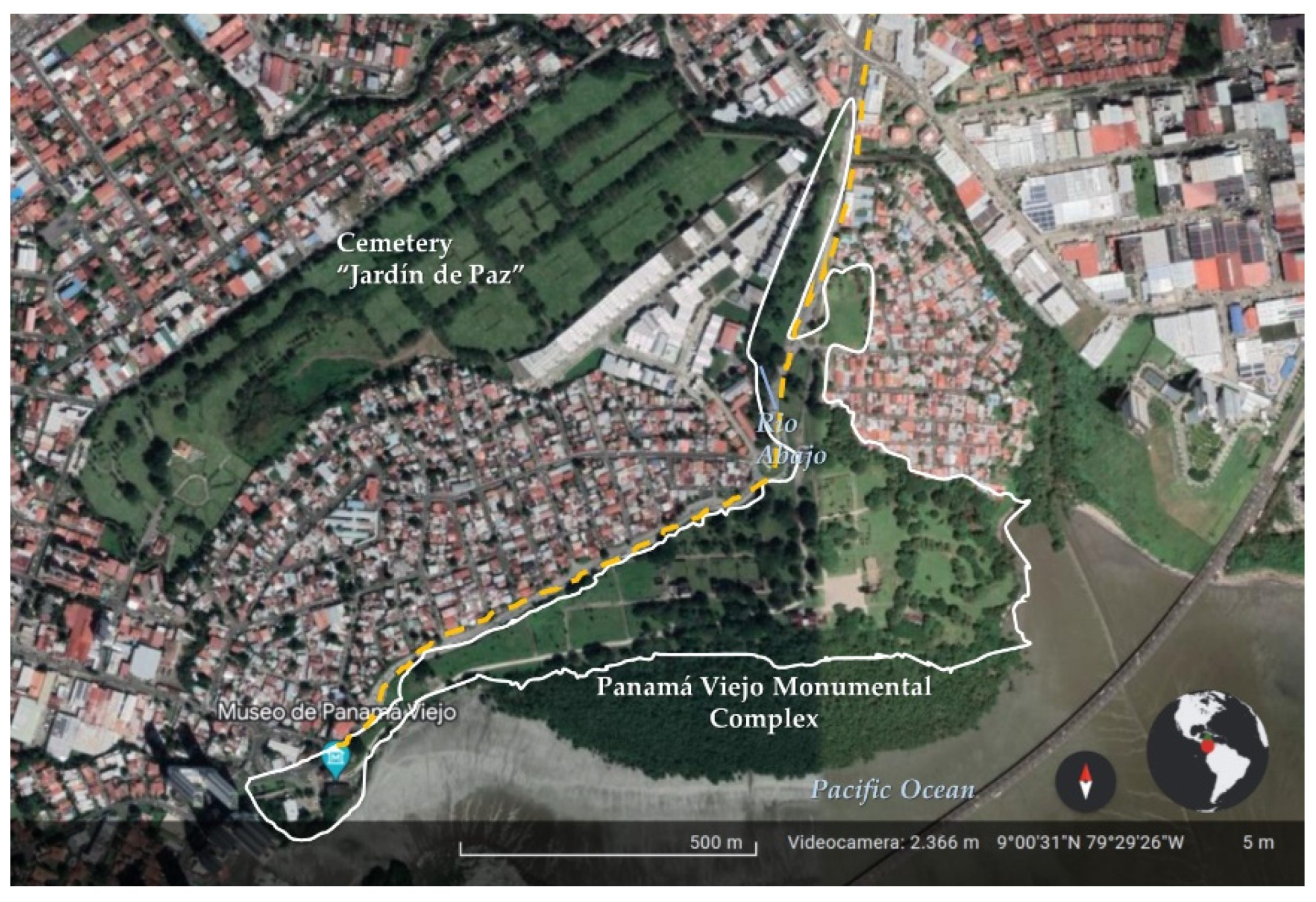
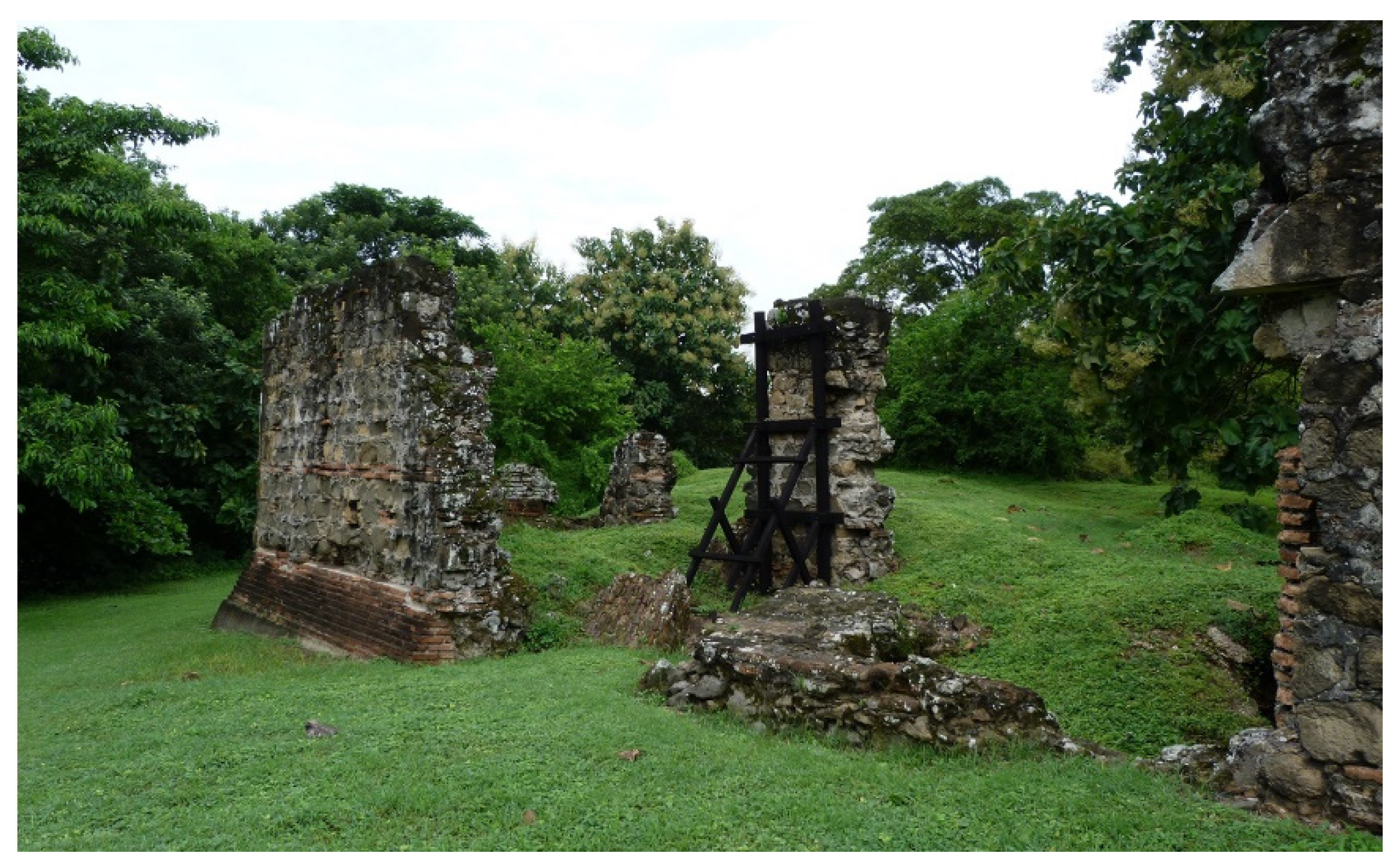

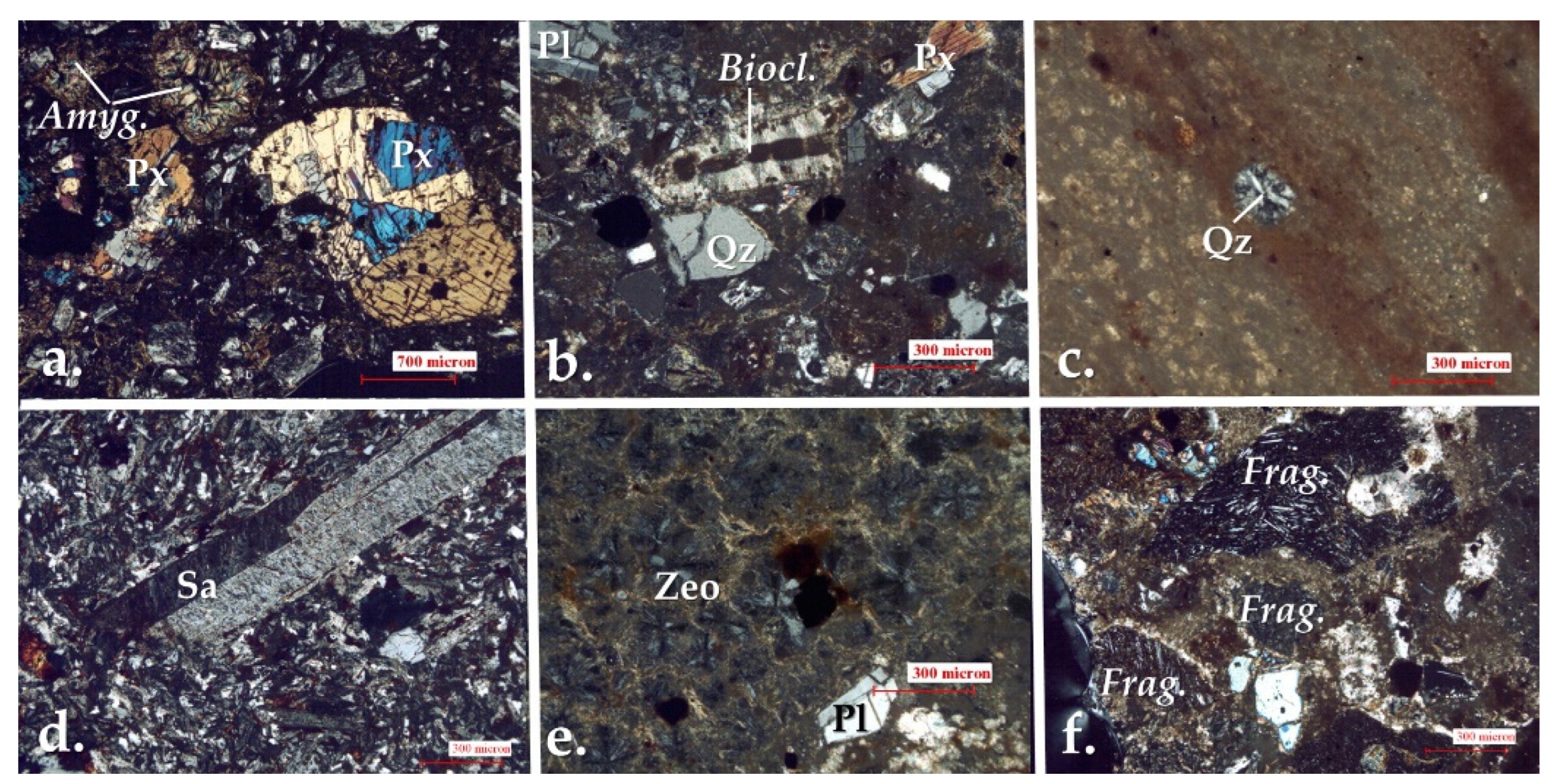

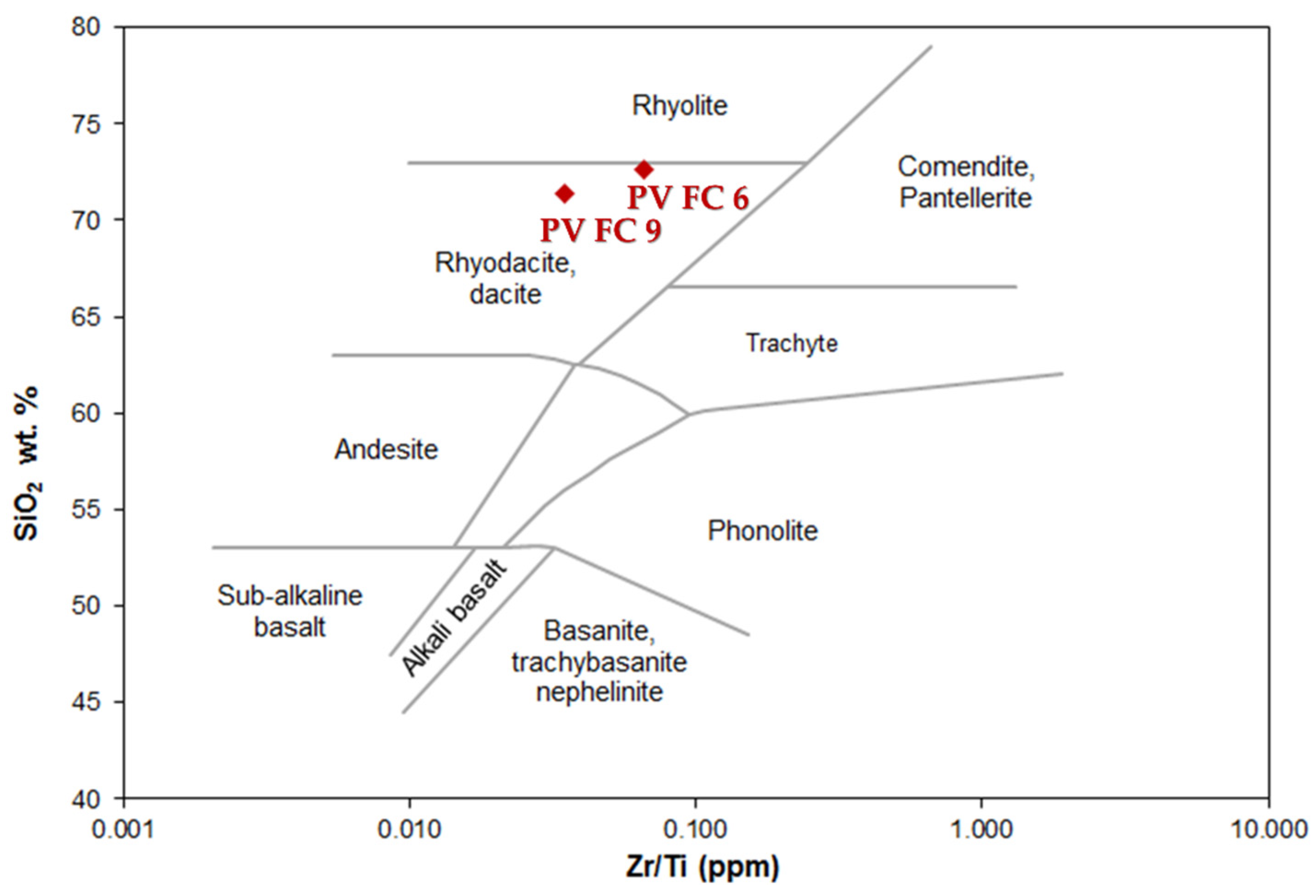


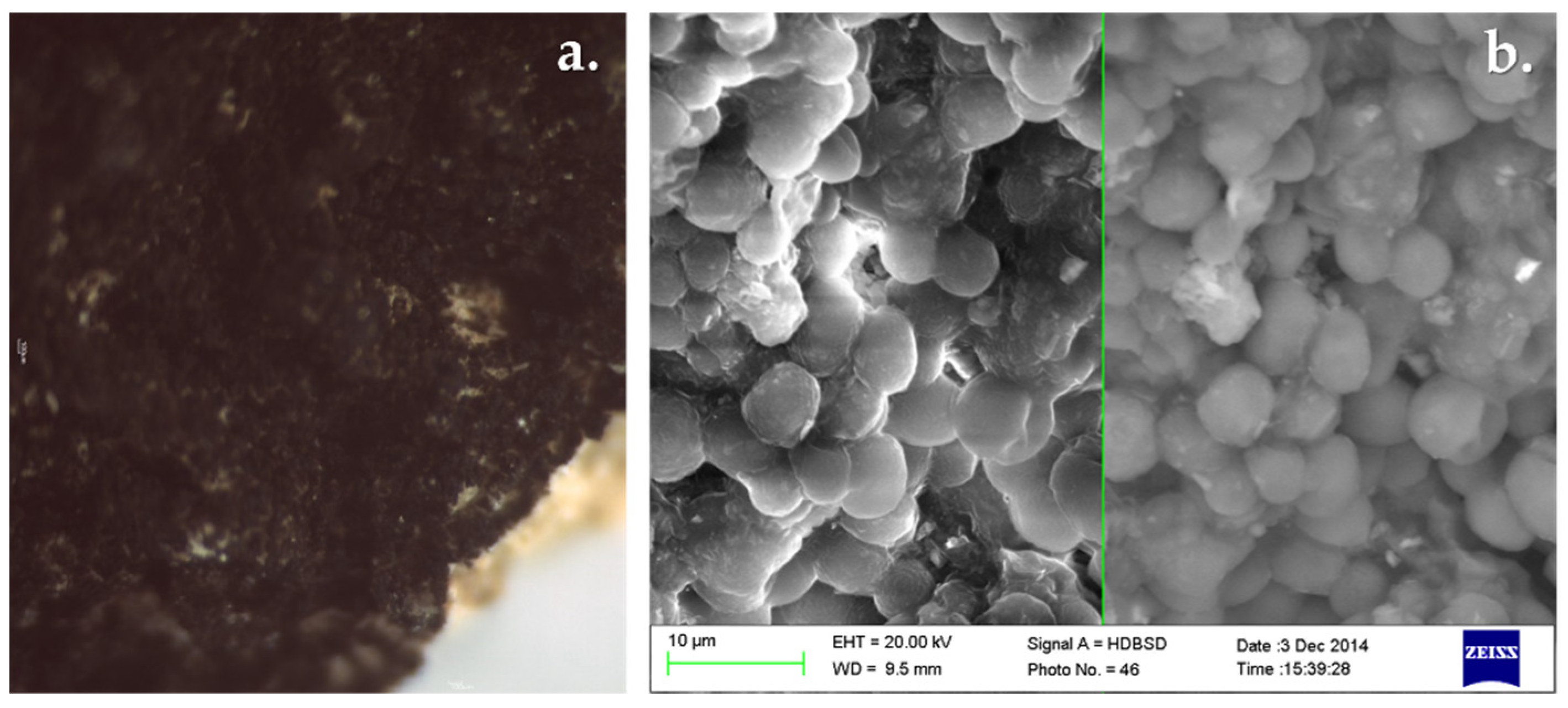
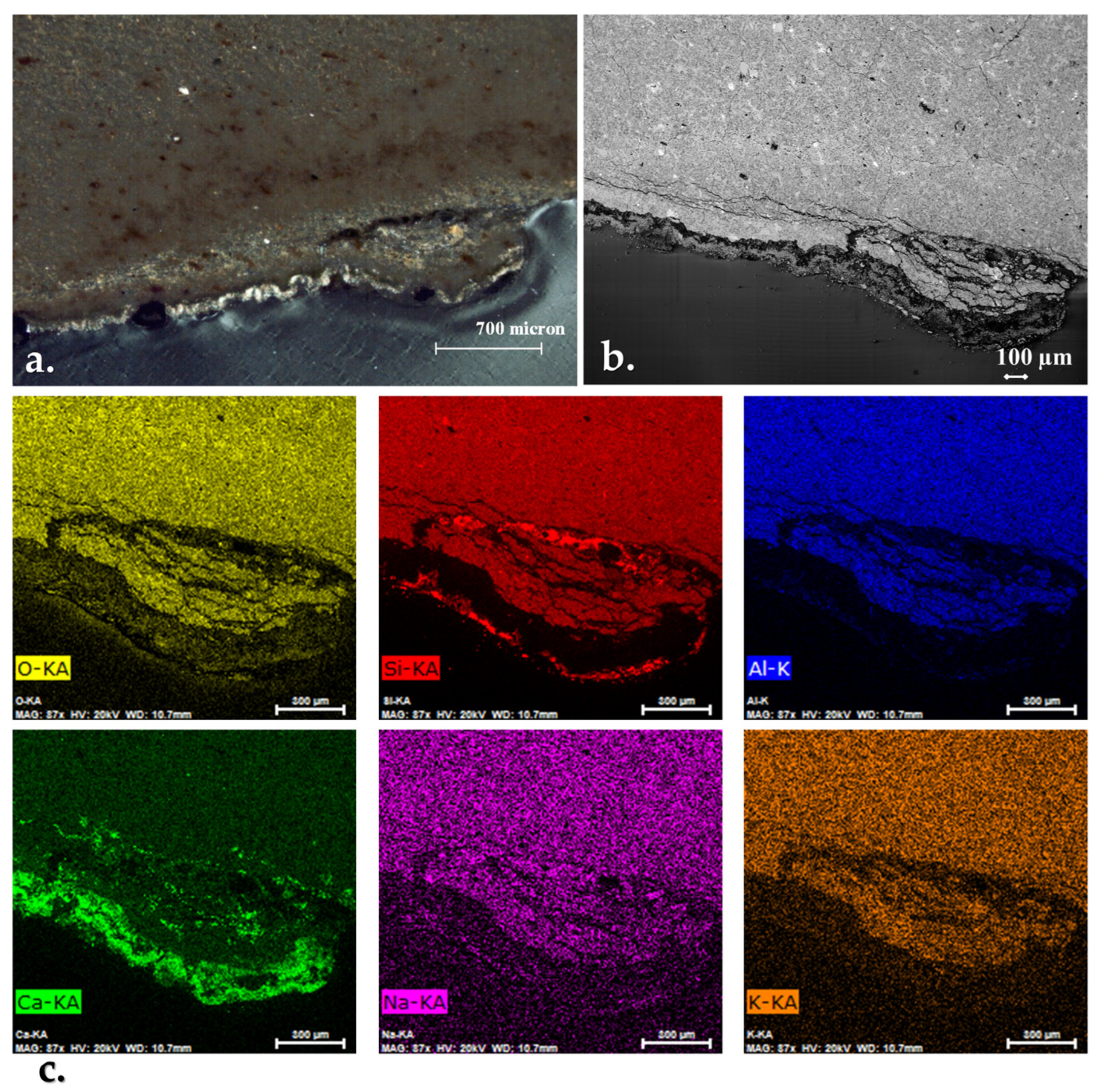
| Sample | Lithotype | Deterioration Patterns | Sampling Location | Picture | Analyses Performed |
|---|---|---|---|---|---|
| PANAMÁ VIEJO—Masonry | |||||
| |||||
| PV FN 1 | Breccia | Biological colonization (algae), partial detachment (exfoliation) | S wall—External part, h 100 cm | 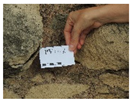 | PLM; XRPD; ESEM-EDS (ts); XRF; IC |
| PV FN 2 | Breccia | No evident deterioration was detected | S wall—External part, h 20 cm | 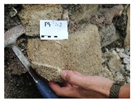 | PLM; XRPD; XRF; MIP |
| PV FN 4 | Basaltic andesite | Partial erosion | W wall—Inner part, h 102 cm | 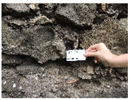 | PLM; ESEM-EDS (ts); XRPD; XRF; MIP |
| PV FN 5 | Basaltic andesite | No evident deterioration was detected | Inner part of the Fortress, ground level |  | PLM; XRPD; XRF; MIP |
| |||||
| PV FC 4 | Breccia | No evident deterioration was detected | E wall of the navy, ground level |  | PLM; ESEM-EDS (ts); XRPD; XRF; MIP |
| PV FC 5 | Breccia | Exfoliation. | E wall of the navy, h 106 cm |  | PLM; XRPD; IC |
| PV FC 6 | Rhyodacite | Partial delamination and discoloration | E wall of the Convent, h 170 cm |  | PLM; ESEM-EDS (ts); XRPD; XRF; MIP; IC |
| PV FC 7 | Breccia | Exfoliation, differential erosion/coving | W wall, h 175 cm |  | PLM; ESEM-EDS (ts); XRPD; XRF |
| PV FC 8 | Breccia | Exfoliation, differential erosion/alveolization, biological colonization (algae) | W wall, h 100 cm | 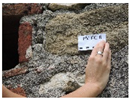 | PLM; XRPD; XRF; IC |
| PV FC 9 | Rhyodacite | Exfoliation, differential erosion/alveolization, partial biological colonization (algae) | W wall, h 200 cm |  | PLM; XRPD; XRF; IC |
| PV FC 11 | Breccia | Blackening/biological colonization (algae) | S-W side of the wall of the complex 9.70 m from the new via Cinquentenario, h 140 cm | 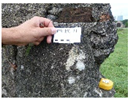 | PLM; XRPD; XRF; IC |
| |||||
| PV SJdD | Rhyodacite | Biological colonization (lichens) and a whitish thin-encrustation on the internal surface | Wall facing the old Via Cinquantenario, h 120–130 cm |  | PLM; ESEM-EDS (ts); XRPD |
| |||||
| PV CC 4 | Breccia | Differential erosion/coving | N side of the chapel, h 140 cm | 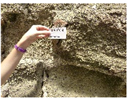 | PLM; XRPD; XRF; MIP |
| PV CC 5 | Breccia | Erosion, biological colonization (algae) | N wall of the nave, h 365 cm |  | PLM; XRPD; XRF |
| PV CC 6 | Breccia | Differential erosion/coving, biological colonization (algae) | Outer wall of the Church, near an eaves, faced S and exposed to the old Via Cinquantenario, h 165–170 cm | 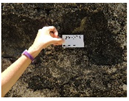 | PLM; XRPD; XRF; IC |
| |||||
| PV JC 1 | Breccia | No evident deterioration was detected (previously covered by plaster, noticed also a bush-hammered surface) | W façade, internal side, inner part of the arch, h 345 cm |  | PLM; XRPD; XRF; MIP |
| PV JC 2 | Breccia | Biological colonization (algae), probably bush-hammered | W façade, internal side, inner part of the arch, h 300 cm | 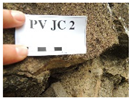 | PLM; XRPD; XRF |
| PV JC 3 | Breccia | No evident deterioration was detected | Near the N façade, ground level | 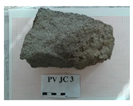 | PLM; XRPD; XRF; MIP (2 specimens for MIP analysis have been obtained, thus the results’ labels show a and b) |
| PV JC 4 | Breccia | No evident deterioration was detected | W wall, h 293 cm | 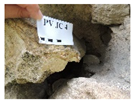 | PLM; XRPD; XRF; MIP; IC |
| |||||
| PV CT 1 | Rhyolite | Biological colonization (lichens) and discoloration (?). | Wall on the W side of Casa Terrin. Sample collected from the N side, h 165 cm | 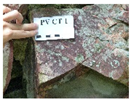 | SM; PLM; XRPD; XRF; µXRF; MIP |
| PV CT 2 | Rhyolite | No evident deterioration was detected | Wall on the W side of Casa Terrin. Sample collected near the S-E corner, ground level |  | PLM; XRPD; XRF; MIP |
| |||||
| PV TC 3 | Tuffite | Exfoliation | W wall, h 109 cm |  | PLM; XRPD; XRF; MIP |
| PV TC 4 | Tuffite | Biological colonization (black algae) | S wall, h 127 cm | 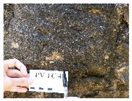 | SM; PLM; ESEM-EDS (bm); XRPD; XRF; MIP; IC |
| |||||
| PV CR 4 | Breccia | Biological colonization (algae), erosion/delamination | S wall, h 160 cm |  | PLM; XRPD; XRF; IC |
| PANAMÁ VIEJO—Outcrops | |||||
| PV Q 1 | Breccia (volcanoclastic) | Biological colonization (black algae) | Outcrop near Casa Reales | 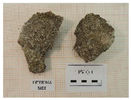 | PLM; MIP |
| PV Q 2 | Basaltic andesite | Biological colonization | Quarry near the Santo Domingo Convent |  | PLM; XRPD; XRF; MIP |
| PV vic. CR | Basaltic andesite | Biological colonization (black algae) | Outcrop near Casa Reales-Location: Lat. 9°0′20.720″–Long.–79°29′0728″ | 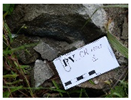 | PLM; XRPD; XRF; MIP |
| Lithology | e.g., Sample | Cal | Fsp | Px | Qtz | Zeo | Hem | Kln | Mnt | Vrm |
|---|---|---|---|---|---|---|---|---|---|---|
| Basaltic andesite | PV FN5 | - | +++ | ++ | - | - | - | - | tr/+ | - |
| Rhyolite | PV CT1 | - | +/++ | - | +++ | - | tr | tr | - | - |
| Rhyodacite | PV FC6 | - | ++ | - | +++ | +++ | - | - | - | - |
| Polygenic Breccia | PV FC7 | +++ | ++ | - | + | ++ | - | - | - | tr |
| Tuffite | PV TC4 | ++ | +++ | + | ++ | ++ | - | - | - | - |
| Accessible Porosity | Inaccessible Porosity | Average Pore Ø | Median Pore Ø | Modal Pore Ø | ||
|---|---|---|---|---|---|---|
| Lithotype | Sample | % | % | μm | μm | μm |
| Polygenic | PV CC 4 | 21.21 | 0.16 | 0.11 | 0.60 | 3.31 |
| breccia | PV FC 4 | 12.32 | 0.09 | 0.06 | 0.09 | 0.05 |
| PV FN 2 | 25.90 | 0.05 | 0.10 | 0.19 | 0.14 | |
| PV JC 1 | 24.09 | 0.01 | 0.08 | 0.15 | 0.19 | |
| PV JC 3A | 27.09 | 0.02 | 0.11 | 0.70 | 2.44 | |
| PV JC 3B | 22.43 | 0.14 | 0.06 | 0.11 | 0.13 | |
| PV JC 4 | 15.96 | 0.33 | 0.04 | 0.05 | 0.06 | |
| PV Q 1 | 29.52 | 1.92 | 0.13 | 0.38 | 1.16 | |
| Tuffite | PV TC 3 | 30.70 | 0.25 | 0.10 | 0.33 | 0.82 |
| PV TC 4 | 26.50 | 1.11 | 0.11 | 0.27 | 0.47 | |
| Basaltic | PV FN 4 | 10.52 | 0.16 | 0.06 | 0.17 | 0.04 |
| andesite | PV FN 5 | 12.14 | 0.08 | 0.07 | 0.22 | 0.29 |
| PV Q 2 | 11.51 | 0.02 | 0.05 | 0.14 | 0.20 | |
| PV vic. CR | 5.23 | 1.32 | 0.05 | 0.08 | 0.06 | |
| Rhyolite | PV CT 1 | 11.57 | 0.23 | 0.13 | 0.20 | 0.22 |
| PV CT 2 | 10.31 | 0.48 | 0.10 | 0.16 | 0.17 | |
| Rhyodacite | PV FC 6 | 27.39 | 0.15 | 0.05 | 0.07 | 0.06 |
| Lithology | Sample | C2H3O2− | PO43− | C2O4= | CHO2− | NO2− | NO3− | SO4− | Cl− | NH4+ | K+ | Mg2+ | Na+ | Ca2+ |
|---|---|---|---|---|---|---|---|---|---|---|---|---|---|---|
| Polygenic Breccia | PVFN1 | 87 | 0 | 2 | 68 | 11 | 1183 | 822 | 1112 | 57 | 325 | 343 | 10,076 | 0 |
| PVFC5 | 7 | 0 | 319 | 37 | 0 | 258 | 576 | 499 | 25 | 244 | 289 | 2077 | 2490 | |
| PVFC8 | 6 | 42 | 24 | 42 | 0 | 129 | 443 | 565 | 19 | 123 | 199 | 1178 | 3038 | |
| PVFC11 | 14 | 0 | 0 | 53 | 1 | 67 | 173 | 640 | 89 | 354 | 369 | 573 | 19,930 | |
| PVCC6 | 17 | 7 | 0 | 37 | 0 | 115 | 572 | 382 | 0 | 224 | 1123 | 850 | 27,884 | |
| PVJC4 | 3 | 0 | 0 | 31 | 11 | 3551 | 2848 | 3821 | 0 | 0 | 15 | 287 | 341 | |
| PVCR 4 | 6 | 0 | 12 | 25 | 6 | 39 | 162 | 579 | 27 | 314 | 823 | 2434 | 8845 | |
| Tuffite | PVTC 4 | 0 | 0 | 34 | 75 | 62 | 6352 | 3098 | 10,675 | 99 | 237 | 294 | 5306 | 33,039 |
| Rhyodacite | PVFC 6 | 4 | 199 | 0 | 17 | 27 | 1033 | 775 | 1739 | 25 | 250 | 288 | 1518 | 1787 |
| PVFC 9 | 1088 | 143 | 0 | 41 | 26 | 1051 | 634 | 1334 | 35 | 244 | 353 | 3672 | 1775 |
| Salt | Temperature (°C) | ||||
|---|---|---|---|---|---|
| Name | Formula | 20 | 25 | 30 | |
| Panamanian range | Nitratite | NaNO3 | 75.4 | 74.3 | 73.1 |
| Halite | NaCl | 75.5 | 75.3 | 75.1 | |
| Thenardite | Na2SO4 | 82 | 82.8 | 84.3 | |
| Sylvite | KCl | 85.1 | 84.3 | 83.6 | |
| Epsomite | MgSO4 •7H2O | 90.1 | 88.3 | 88 | |
| Natron | Na2CO3 •10H2O | 97.9 | 88.2 | 83.2 | |
| Mirabilite | Na2SO4 •10H2O | 93.6 | 91.4 | 87.9 | |
| Niter | KNO3 | 94.6 | 93.6 | 92.3 | |
| Arcanite | K2SO4 | 97.6 | 97.3 | 97 | |
Disclaimer/Publisher’s Note: The statements, opinions and data contained in all publications are solely those of the individual author(s) and contributor(s) and not of MDPI and/or the editor(s). MDPI and/or the editor(s) disclaim responsibility for any injury to people or property resulting from any ideas, methods, instructions or products referred to in the content. |
© 2023 by the authors. Licensee MDPI, Basel, Switzerland. This article is an open access article distributed under the terms and conditions of the Creative Commons Attribution (CC BY) license (https://creativecommons.org/licenses/by/4.0/).
Share and Cite
Ciantelli, C.; Arroyo Duarte, S.I.; Vaccaro, C.; Bonazza, A. Characterization of the Stone Masonries and Evaluation of the Environmental Impact in Panamá Viejo: A Contribution for the Conservation of the Monumental Complex. Heritage 2023, 6, 6526-6546. https://doi.org/10.3390/heritage6100341
Ciantelli C, Arroyo Duarte SI, Vaccaro C, Bonazza A. Characterization of the Stone Masonries and Evaluation of the Environmental Impact in Panamá Viejo: A Contribution for the Conservation of the Monumental Complex. Heritage. 2023; 6(10):6526-6546. https://doi.org/10.3390/heritage6100341
Chicago/Turabian StyleCiantelli, Chiara, Silvia I. Arroyo Duarte, Carmela Vaccaro, and Alessandra Bonazza. 2023. "Characterization of the Stone Masonries and Evaluation of the Environmental Impact in Panamá Viejo: A Contribution for the Conservation of the Monumental Complex" Heritage 6, no. 10: 6526-6546. https://doi.org/10.3390/heritage6100341







